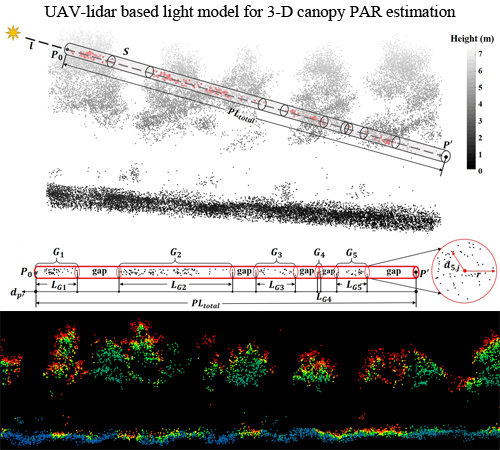Modelling Three-Dimensional Spatiotemporal Distributions of Forest Photosynthetically Active Radiation Using UAV-Based Lidar Data
Abstract
:1. Introduction
- Develop and validate a spatially explicit lidar-based 3-D forest canopy PAR simulation model treating direct and diffuse solar radiation separately;
- Characterize the attenuation effects of direct solar PAR along its transmission path penetrating through a forest canopy, and
- Explore the spatiotemporal variations of forest PAR in 3-D space and the effects of point density on the estimation accuracy of forest PAR simulation.
2. Materials and Methods
2.1. Study Sites
2.2. Data Collection
2.2.1. UAV Lidar Data
2.2.2. TLS Data
2.2.3. Lidar Data Pre-Processing
2.2.4. Field-Based PAR Measurements
2.2.5. PAR Measurements Normalization
2.3. Model Development
2.3.1. Direct PAR Estimation Model
2.3.2. Diffuse PAR Estimation Model
2.3.3. Scattering PAR Estimation Model
2.4. Model Parameters Determination
2.5. UAV Lidar Data Thinning
2.6. Spatiotemporal Variations of Forest PAR
3. Results
3.1. Determined Parameters of Direct Light Attenuation Model
3.2. Determined Parameters of Sky Diffuse PAR Model
3.3. Comparisons between the UAV- and Field-Based PARs
3.4. Spatiotemporal Distribution Patterns of Forest PAR
4. Discussion
4.1. Sensitivity Analysis of 3D Ray Trace Model
4.2. Comparison among Three Different Path Length-Based PAR Models
4.3. Sensitivity Analysis of Sky Diffuse PAR Model
4.4. Effects of Isotropic and Anisotropic Sky Diffuse Distributions
4.5. Effects of Point Density
4.6. Model Evaluation
5. Conclusions
Author Contributions
Funding
Acknowledgments
Conflicts of Interest
References
- Kobayashi, H.; Baldocchi, D.D.; Ryu, Y.; Chen, Q.; Ma, S.; Osuna, J.L.; Ustin, S.L. Modeling energy and carbon fluxes in a heterogeneous oak woodland: A three-dimensional approach. Agric. For. Meteorol. 2012, 152, 83–100. [Google Scholar] [CrossRef]
- Magney, T.S.; Eitel, J.U.H.; Griffin, K.L.; Boelman, N.T.; Greaves, H.E.; Prager, C.M.; Logan, B.A.; Zheng, G.; Ma, L.; Fortin, E.A.; et al. LiDAR canopy radiation model reveals patterns of photosynthetic partitioning in an Arctic shrub. Agric. For. Meteorol. 2016, 221, 78–93. [Google Scholar] [CrossRef]
- Musselman, K.N.; Molotch, N.P.; Margulis, S.A.; Lehning, M.; Gustafsson, D. Improved snowmelt simulations with a canopy model forced with photo-derived direct beam canopy transmissivity. Water Resour. Res. 2012, 48. [Google Scholar] [CrossRef]
- Pomeroy, J.; Rowlands, A.; Hardy, J.; Link, T.; Marks, D.; Essery, R.; Sicart, J.E.; Ellis, C. Spatial Variability of Shortwave Irradiance for Snowmelt in Forests. J. Hydrometeorol. 2008, 9, 1482–1490. [Google Scholar] [CrossRef]
- von Arx, G.; Dobbertin, M.; Rebetez, M. Spatio-temporal effects of forest canopy on understory microclimate in a long-term experiment in Switzerland. Agric. For. Meteorol. 2012, 166–167, 144–155. [Google Scholar] [CrossRef]
- Barbour, M.M.; Hunt, J.E.; Walcroft, A.S.; Rogers, G.N.D.; McSeveny, T.M.; Whitehead, D. Components of ecosystem evaporation in a temperate coniferous rainforest, with canopy transpiration scaled using sapwood density. New Phytol. 2005, 165, 549–558. [Google Scholar] [CrossRef]
- Svenning, J.C. Crown illumination limits the population growth rate of a neotropical understorey palm (Geonoma macrostachys, Arecaceae). Plant Ecol. 2002, 159, 185–199. [Google Scholar] [CrossRef]
- Sakai, T.; Akiyama, T. Quantifying the spatio-temporal variability of net primary production of the understory species, Sasa senanensis, using multipoint measuring techniques. Agric. For. Meteorol. 2005, 134, 60–69. [Google Scholar] [CrossRef]
- Ross, J. The Radiation Regime and Architecture of Plant Stands; Dr W. Junk Publishers: The Hague, The Netherlands, 1981. [Google Scholar]
- Kucharik, C.J.; Norman, J.M.; Gower, S.T. Characterization of radiation regimes in nonrandom forest canopies: Theory, measurements, and a simplified modeling approach. Tree Physiol. 1999, 19, 695–706. [Google Scholar] [CrossRef]
- Ameztegui, A.; Coll, L.; Benavides, R.; Valladares, F.; Paquette, A. Understory light predictions in mixed conifer mountain forests: Role of aspect-induced variation in crown geometry and openness. For. Ecol. Manag. 2012, 276, 52–61. [Google Scholar] [CrossRef]
- Govind, A.; Guyon, D.; Roujean, J.L.; Yauschew-Raguenes, N.; Kumari, J.; Pisek, J.; Wigneron, J.P. Effects of canopy architectural parameterizations on the modeling of radiative transfer mechanism. Ecol. Model. 2013, 251, 114–126. [Google Scholar] [CrossRef]
- Link, T.E.; Marks, D.; Hardy, J.P. A deterministic method to characterize canopy radiative transfer properties. Hydrol. Process. 2004, 18, 3583–3594. [Google Scholar] [CrossRef]
- Peng, S.Z.; Zhao, C.Y.; Xu, Z.L. Modeling spatiotemporal patterns of understory light intensity using airborne laser scanner (LiDAR). ISPRS J. Photogramm. Remote Sens. 2014, 97, 195–203. [Google Scholar] [CrossRef]
- Musselman, K.N.; Pomeroy, J.W.; Link, T.E. Variability in shortwave irradiance caused by forest gaps: Measurements, modelling, and implications for snow energetics. Agric. For. Meteorol. 2015, 207, 69–82. [Google Scholar] [CrossRef]
- Webster, C.; Rutter, N.; Zahner, F.; Jonas, T. Measurement of Incoming Radiation below Forest Canopies: A Comparison of Different Radiometer Configurations. J. Hydrometeorol. 2016, 17, 853–864. [Google Scholar] [CrossRef]
- Hardy, J.P.; Melloh, R.; Koenig, G.; Marks, D.; Winstral, A.; Pomeroy, J.W.; Link, T. Solar radiation transmission through conifer canopies. Agric. For. Meteorol. 2004, 126, 257–270. [Google Scholar] [CrossRef]
- Musselman, K.N.; Molotch, N.P.; Margulis, S.A.; Kirchner, P.B.; Bales, R.C. Influence of canopy structure and direct beam solar irradiance on snowmelt rates in a mixed conifer forest. Agric. For. Meteorol. 2012, 161, 46–56. [Google Scholar] [CrossRef]
- Isabelle, P.E.; Nadeau, D.F.; Asselin, M.H.; Harvey, R.; Musselman, K.N.; Rousseau, A.N.; Anctil, F. Solar radiation transmittance of a boreal balsam fir canopy: Spatiotemporal variability and impacts on growing season hydrology. Agric. For. Meteorol. 2018, 263, 1–14. [Google Scholar] [CrossRef]
- Widlowski, J.-L.; Mio, C.; Disney, M.; Adams, J.; Andredakis, I.; Atzberger, C.; Brennan, J.; Busetto, L.; Chelle, M.; Ceccherini, G.; et al. The fourth phase of the radiative transfer model intercomparison (RAMI) exercise: Actual canopy scenarios and conformity testing. Remote Sens. Environ. 2015, 169, 418–437. [Google Scholar] [CrossRef]
- Norman, J.M.; Welles, J.M. Radiative-transfer in an array of canopies. Agron. J. 1983, 75, 481–488. [Google Scholar] [CrossRef]
- Lieffers, V.J.; Messier, C.; Stadt, K.J.; Gendron, F.; Comeau, P.G. Predicting and managing light in the understory of boreal forests. Can. J. For. Res. 1999, 29, 796–811. [Google Scholar] [CrossRef]
- Song, C.H.; Band, L.E. MVP: A model to simulate the spatial patterns of photosynthetically active radiation under discrete forest canopies. Can. J. For. Res. Rev. Can. Rech. For. 2004, 34, 1192–1203. [Google Scholar] [CrossRef]
- Kobayashi, H.; Iwabuchi, H. A coupled 1-D atmosphere and 3-D canopy radiative transfer model for canopy reflectance, light environment, and photosynthesis simulation in a heterogeneous landscape. Remote Sens. Environ. 2008, 112, 173–185. [Google Scholar] [CrossRef]
- Iio, A.; Kakubari, Y.; Mizunaga, H. A three-dimensional light transfer model based on the vertical point-quadrant method and Monte-Carlo simulation in a Fagus crenata forest canopy on Mount Naeba in Japan. Agric. For. Meteorol. 2011, 151, 461–479. [Google Scholar] [CrossRef]
- GastelluEtchegorry, J.P.; Demarez, V.; Pinel, V.; Zagolski, F. Modeling radiative transfer in heterogeneous 3-D vegetation canopies. Remote Sens. Environ. 1996, 58, 131–156. [Google Scholar] [CrossRef]
- Monsi, M.; Saeki, T. On the factor light in plant communities and its importance for matter production. Ann. Bot. 2005, 95, 549–567. [Google Scholar] [CrossRef]
- Ellis, C.R.; Pomeroy, J.W. Estimating sub-canopy shortwave irradiance to melting snow on forested slopes. Hydrol. Process. 2007, 21, 2581–2593. [Google Scholar] [CrossRef]
- Essery, R.; Bunting, P.; Hardy, J.; Link, T.; Marks, D.; Melloh, R.; Pomeroy, J.; Rowlands, A.; Rutter, N. Radiative transfer modeling of a coniferous canopy characterized by airborne remote sensing. J. Hydrometeorol. 2008, 9, 228–241. [Google Scholar] [CrossRef]
- Seyednasrollah, B.; Kumar, M. Effects of tree morphometry on net snow cover radiation on forest floor for varying vegetation densities. J. Geophys. Res. Atmos. 2013, 118, 12508–12521. [Google Scholar] [CrossRef]
- Duursma, R.A.; Falster, D.S.; Valladares, F.; Sterck, F.J.; Pearcy, R.W.; Lusk, C.H.; Sendall, K.M.; Nordenstahl, M.; Houter, N.C.; Atwell, B.J.; et al. Light interception efficiency explained by two simple variables: A test using a diversity of small- to medium-sized woody plants. New Phytol. 2012, 193, 397–408. [Google Scholar] [CrossRef]
- Olpenda, A.S.; Sterenczak, K.; Bedkowski, K. Modeling Solar Radiation in the Forest Using Remote Sensing Data: A Review of Approaches and Opportunities. Remote Sens. 2018, 10, 694. [Google Scholar] [CrossRef] [Green Version]
- Ma, L.X.; Zheng, G.; Eitel, J.U.H.; Magney, T.S.; Moskal, L.M. Retrieving forest canopy extinction coefficient from terrestrial and airborne lidar. Agric. For. Meteorol. 2017, 236, 1–21. [Google Scholar] [CrossRef]
- Zheng, G.; Ma, L.X.; Eitel, J.U.H.; He, W.; Magney, T.S.; Moskal, L.M.; Li, M.S. Retrieving Directional Gap Fraction, Extinction Coefficient, and Effective Leaf Area Index by Incorporating Scan Angle Information From Discrete Aerial Lidar Data. IEEE Trans. Geosci. Remote 2017, 55, 577–590. [Google Scholar] [CrossRef]
- Dutta, D.; Wang, K.; Lee, E.; Goodwell, A.; Woo, D.K.; Wagner, D.; Kumar, P. Characterizing Vegetation Canopy Structure Using Airborne Remote Sensing Data. IEEE Trans. Geosci. Remote 2017, 55, 1160–1178. [Google Scholar] [CrossRef]
- Kükenbrink, D.; Schneider, F.D.; Leiterer, R.; Schaepman, M.E.; Morsdorf, F. Quantification of hidden canopy volume of airborne laser scanning data using a voxel traversal algorithm. Remote Sens. Environ. 2017, 194, 424–436. [Google Scholar] [CrossRef]
- Lee, H.; Slatton, K.C.; Roth, B.E.; Cropper, W.P. Prediction of forest canopy light interception using three-dimensional airborne LiDAR data. Int. J. Remote Sens. 2009, 30, 189–207. [Google Scholar] [CrossRef]
- Tymen, B.; Vincent, G.; Courtois, E.A.; Heurtebize, J.; Dauzat, J.; Marechaux, I.; Chave, J. Quantifying micro-environmental variation in tropical rainforest understory at landscape scale by combining airborne LiDAR scanning and a sensor network. Ann. For. Sci. 2017, 74, 32. [Google Scholar] [CrossRef]
- Bode, C.A.; Limm, M.P.; Power, M.E.; Finlay, J.C. Subcanopy Solar Radiation model: Predicting solar radiation across a heavily vegetated landscape using LiDAR and GIS solar radiation models. Remote Sens. Environ. 2014, 154, 387–397. [Google Scholar] [CrossRef]
- Oshio, H.; Asawa, T. Estimating the Solar Transmittance of Urban Trees Using Airborne LiDAR and Radiative Transfer Simulation. IEEE Trans. Geosci. Remote 2016, 54, 5483–5492. [Google Scholar] [CrossRef]
- Mücke, W.; Hollaus, M. Modelling light conditions in forests using airborne laser scanning data. In Proceedings of the SilviLaser 2011, 11th International Conference on LiDAR Applications for Assessing Forest Ecosystems, Hobart, Australia, 16–20 October 2011. [Google Scholar]
- Musselman, K.N.; Margulis, S.A.; Molotch, N.P. Estimation of solar direct beam transmittance of conifer canopies from airborne LiDAR. Remote Sens. Environ. 2013, 136, 402–415. [Google Scholar] [CrossRef]
- Varhola, A.; Coops, N.C. Estimation of watershed-level distributed forest structure metrics relevant to hydrologic modeling using LiDAR and Landsat. J. Hydrol. 2013, 487, 70–86. [Google Scholar] [CrossRef]
- Moeser, D.; Roubinek, J.; Schleppi, P.; Morsdorf, F.; Jonas, T. Canopy closure, LAI and radiation transfer from airborne LiDAR synthetic images. Agric. For. Meteorol. 2014, 197, 158–168. [Google Scholar] [CrossRef]
- Van der Zande, D.; Stuckens, J.; Verstraeten, W.W.; Muys, B.; Coppin, P. Assessment of Light Environment Variability in Broadleaved Forest Canopies Using Terrestrial Laser Scanning. Remote Sens. 2010, 2, 1564–1574. [Google Scholar] [CrossRef] [Green Version]
- Cifuentes, R.; Van der Zande, D.; Salas, C.; Tits, L.; Farifteh, J.; Coppin, P. Modeling 3D Canopy Structure and Transmitted PAR Using Terrestrial LiDAR. Can. J. Remote Sens. 2017, 43, 124–139. [Google Scholar] [CrossRef]
- Wallace, L.; Lucieer, A.; Watson, C.S. Evaluating Tree Detection and Segmentation Routines on Very High Resolution UAV LiDAR Data. IEEE Trans. Geosci. Remote 2014, 52, 7619–7628. [Google Scholar] [CrossRef]
- Brede, B.; Lau, A.; Bartholomeus, H.M.; Kooistra, L. Comparing RIEGL RiCOPTER UAV LiDAR Derived Canopy Height and DBH with Terrestrial LiDAR. Sensors 2017, 17, 2371. [Google Scholar] [CrossRef]
- Nyman, P.; Metzen, D.; Hawthorne, S.N.D.; Duff, T.J.; Inbar, A.; Lane, P.N.J.; Sheridan, G.J. Evaluating models of shortwave radiation below Eucalyptus canopies in SE Australia. Agric. For. Meteorol. 2017, 246, 51–63. [Google Scholar] [CrossRef]
- Cescatti, A. Modelling the radiative transfer in discontinuous canopies of asymmetric crowns. I. Model structure and algorithms. Ecol. Model. 1997, 101, 263–274. [Google Scholar] [CrossRef]
- Kandare, K.; Orka, H.O.; Chan, J.C.-W.; Dalponte, M. Effects of forest structure and airborne laser scanning point cloud density on 3D delineation of individual tree crowns. Eur. J. Remote Sens. 2016, 49, 337–359. [Google Scholar] [CrossRef] [Green Version]
- Grant, R.H.; Heisler, G.M.; Gao, W. Photosynthetically-active radiation: Sky radiance distributions under clear and overcast conditions. Agric. For. Meteorol. 1996, 82, 267–292. [Google Scholar] [CrossRef]
- Nouvellon, Y.; Begue, A.; Moran, M.S.; Lo Seen, D.; Rambal, S.; Luquet, D.; Chehbouni, G.; Inoue, Y. PAR extinction in shortgrass ecosystems: Effects of clumping, sky conditions and soil albedo. Agric. For. Meteorol. 2000, 105, 21–41. [Google Scholar] [CrossRef] [Green Version]
- Jain, A.K. Data clustering: 50 years beyond K-means. Pattern Recognit. Lett. 2010, 31, 651–666. [Google Scholar] [CrossRef]
- Zheng, G.; Ma, L.X.; He, W.; Eitel, J.U.H.; Moskal, L.M.; Zhang, Z.Y. Assessing the Contribution of Woody Materials to Forest Angular Gap Fraction and Effective Leaf Area Index Using Terrestrial Laser Scanning Data. IEEE Trans. Geosci. Remote 2016, 54, 1475–1487. [Google Scholar] [CrossRef]
- Zheng, G.; Moskal, L.M.; Kim, S.H. Retrieval of Effective Leaf Area Index in Heterogeneous Forests with Terrestrial Laser Scanning. IEEE Trans Geosci. Remote 2013, 51, 777–786. [Google Scholar] [CrossRef]
- Frazer, G.W.; Fournier, R.A.; Trofymow, J.A.; Hall, R.J. A comparison of digital and film fisheye photography for analysis of forest canopy structure and gap light transmission. Agric. For. Meteorol. 2001, 109, 249–263. [Google Scholar] [CrossRef]
- Liu, J.; Chen, J.M.; Cihlar, J. Mapping evapotranspiration based on remote sensing: An application to Canada’s landmass. Water Resour. Res. 2003, 39. [Google Scholar] [CrossRef]
- Chen, J.M.; Liu, J.; Cihlar, J.; Goulden, M.L. Daily canopy photosynthesis model through temporal and spatial scaling for remote sensing applications. Ecol. Model. 1999, 124, 99–119. [Google Scholar] [CrossRef] [Green Version]
- Ma, L.; Zheng, G.; Wang, X.; Li, S.; Lin, Y.; Ju, W. Retrieving forest canopy clumping index using terrestrial laser scanning data. Remote Sens. Environ. 2018, 210, 452–472. [Google Scholar] [CrossRef] [Green Version]
- Hirose, T. Development of the Monsi-Saeki theory on canopy structure and function. Ann. Bot. 2005, 95, 483–494. [Google Scholar] [CrossRef] [Green Version]
- Fuchs, M.; Asrar, G.; Kanemasu, E.T.; Hipps, L.E. Leaf area estimates from measurements of photosynthetically active radiation in wheat canopies. Agric. For. Meteorol. 1984, 32, 13–22. [Google Scholar] [CrossRef]
- Alexander, C.; Moeslund, J.E.; Bocher, P.K.; Arge, L.; Svenning, J.C. Airborne laser scanner (LiDAR) proxies for understory light conditions. Remote Sens. Environ. 2013, 134, 152–161. [Google Scholar] [CrossRef]
- Reda, I.; Andreas, A. Solar position algorithm for solar radiation applications. Sol. Energy 2004, 76, 577–589. [Google Scholar] [CrossRef]
- Riano, D.; Valladares, F.; Condes, S.; Chuvieco, E. Estimation of leaf area index and covered ground from airborne laser scanner (Lidar) in two contrasting forests. Agric. For. Meteorol. 2004, 124, 269–275. [Google Scholar] [CrossRef]
- Solberg, S.; Brunner, A.; Hanssen, K.H.; Lange, H.; Naesset, E.; Rautiainen, M.; Stenberg, P. Mapping LAI in a Norway spruce forest using airborne laser scanning. Remote Sens. Environ. 2009, 113, 2317–2327. [Google Scholar] [CrossRef]
- Morsdorf, F.; Kotz, B.; Meier, E.; Itten, K.I.; Allgower, B. Estimation of LAI and fractional cover from small footprint airborne laser scanning data based on gap fraction. Remote Sens. Environ. 2006, 104, 50–61. [Google Scholar] [CrossRef]
- Richardson, J.J.; Moskal, L.M.; Kim, S.H. Modeling approaches to estimate effective leaf area index from aerial discrete-return LIDAR. Agric. For. Meteorol. 2009, 149, 1152–1160. [Google Scholar] [CrossRef]
- Hancock, S.; Essery, R.; Reid, T.; Carle, J.; Baxter, R.; Rutter, N.; Huntley, B. Characterising forest gap fraction with terrestrial lidar and photography: An examination of relative limitations. Agric. For. Meteorol. 2014, 189, 105–114. [Google Scholar] [CrossRef] [Green Version]
- Calders, K.; Origo, N.; Disney, M.; Nightingale, J.; Woodgate, W.; Armston, J.; Lewis, P. Variability and bias in active and passive ground-based measurements of effective plant, wood and leaf area index. Agric. For. Meteorol. 2018, 252, 231–240. [Google Scholar] [CrossRef]
- Woodgate, W.; Jones, S.D.; Suarez, L.; Hill, M.J.; Armston, J.D.; Wilkes, P.; Soto-Berelov, M.; Haywood, A.; Mellor, A. Understanding the variability in ground-based methods for retrieving canopy openness, gap fraction, and leaf area index in diverse forest systems. Agric. For. Meteorol. 2015, 205, 83–95. [Google Scholar] [CrossRef]
- Reid, T.D.; Essery, R.L.H.; Rutter, N.; King, M. Data- driven modelling of shortwave radiation transfer to snow through boreal birch and conifer canopies. Hydrol. Process. 2014, 28, 2987–3007. [Google Scholar] [CrossRef]
- Hilker, T.; van Leeuwen, M.; Coops, N.C.; Wulder, M.A.; Newnham, G.J.; Jupp, D.L.B.; Culvenor, D.S. Comparing canopy metrics derived from terrestrial and airborne laser scanning in a Douglas-fir dominated forest stand. Trees Struct. Funct. 2010, 24, 819–832. [Google Scholar] [CrossRef]

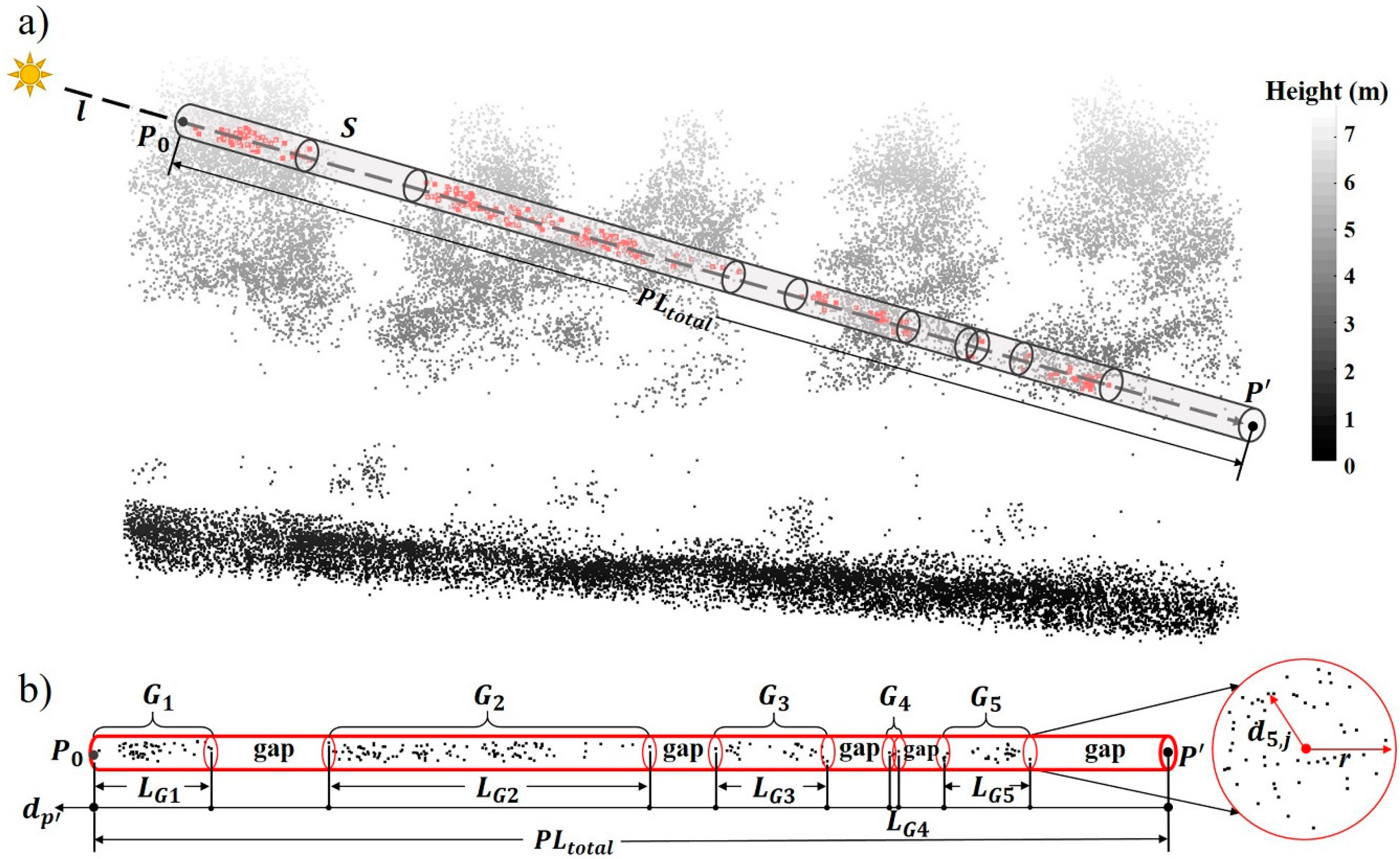
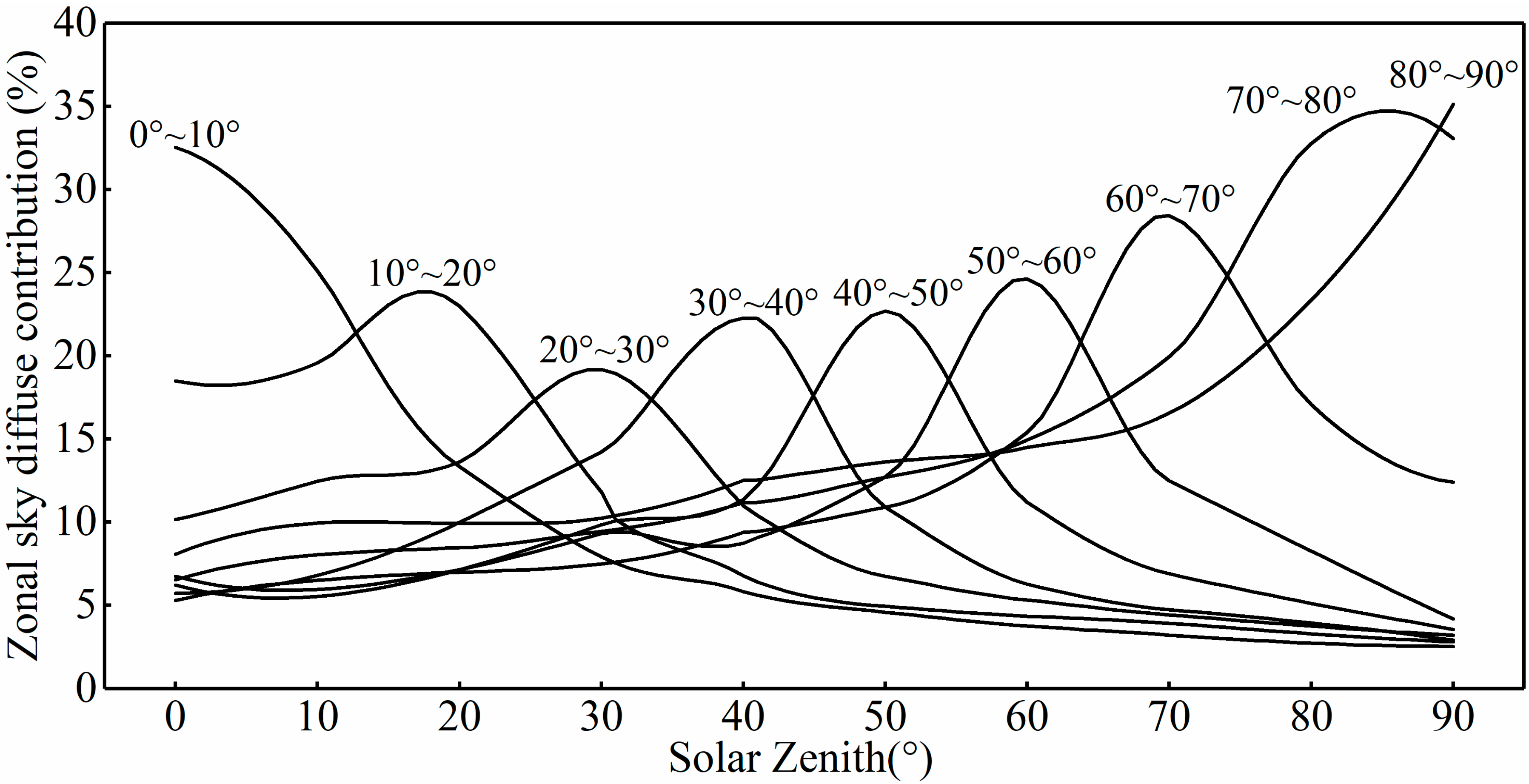

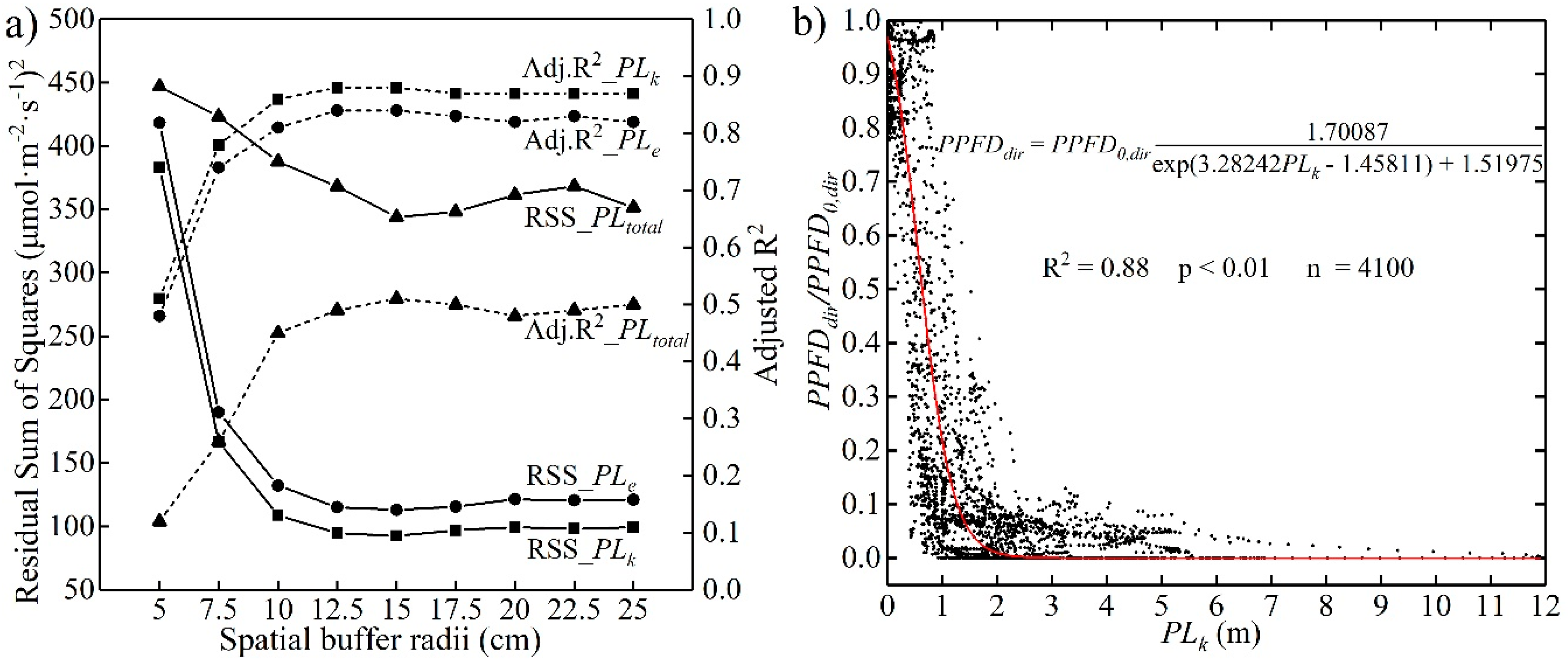


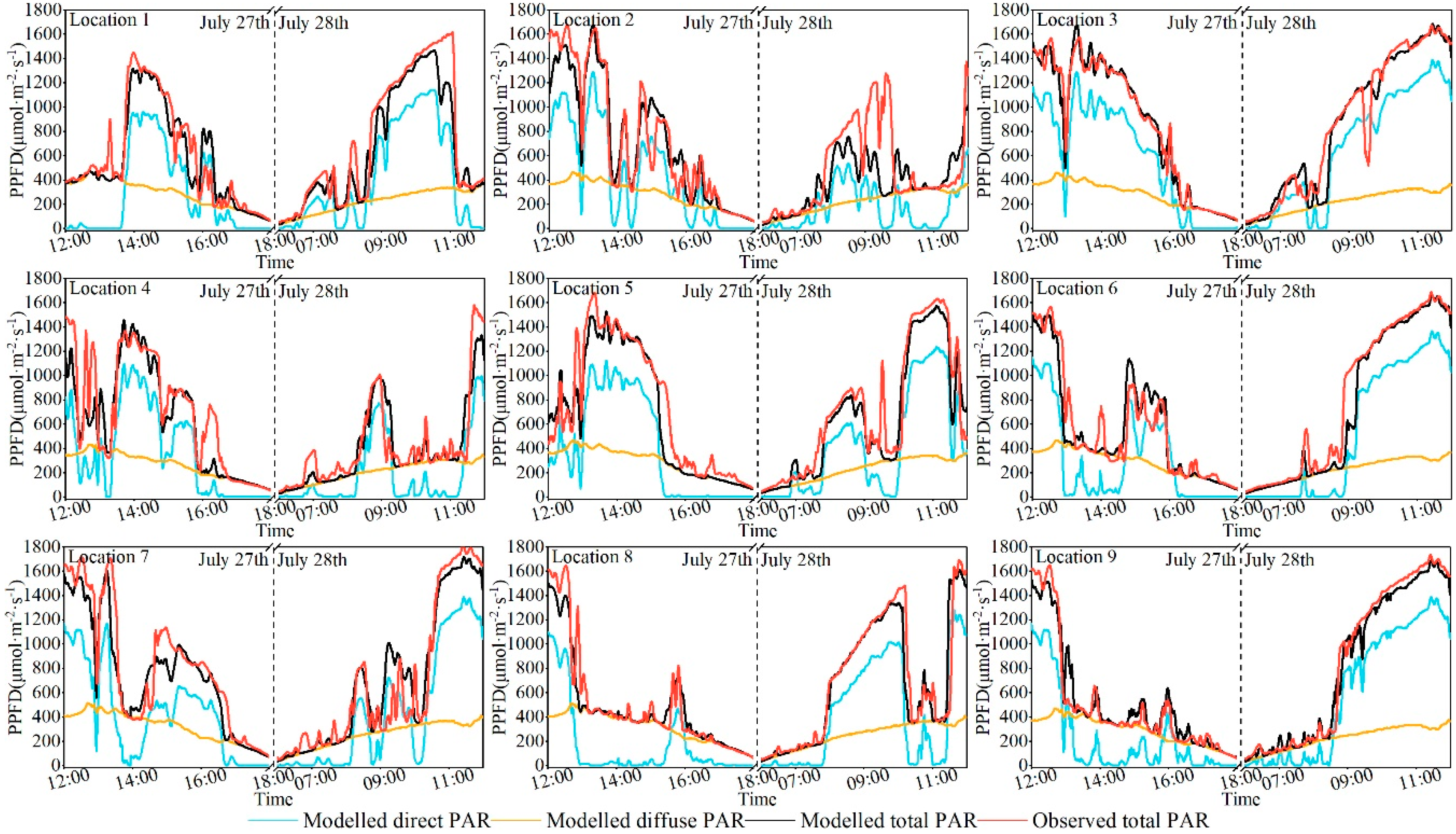

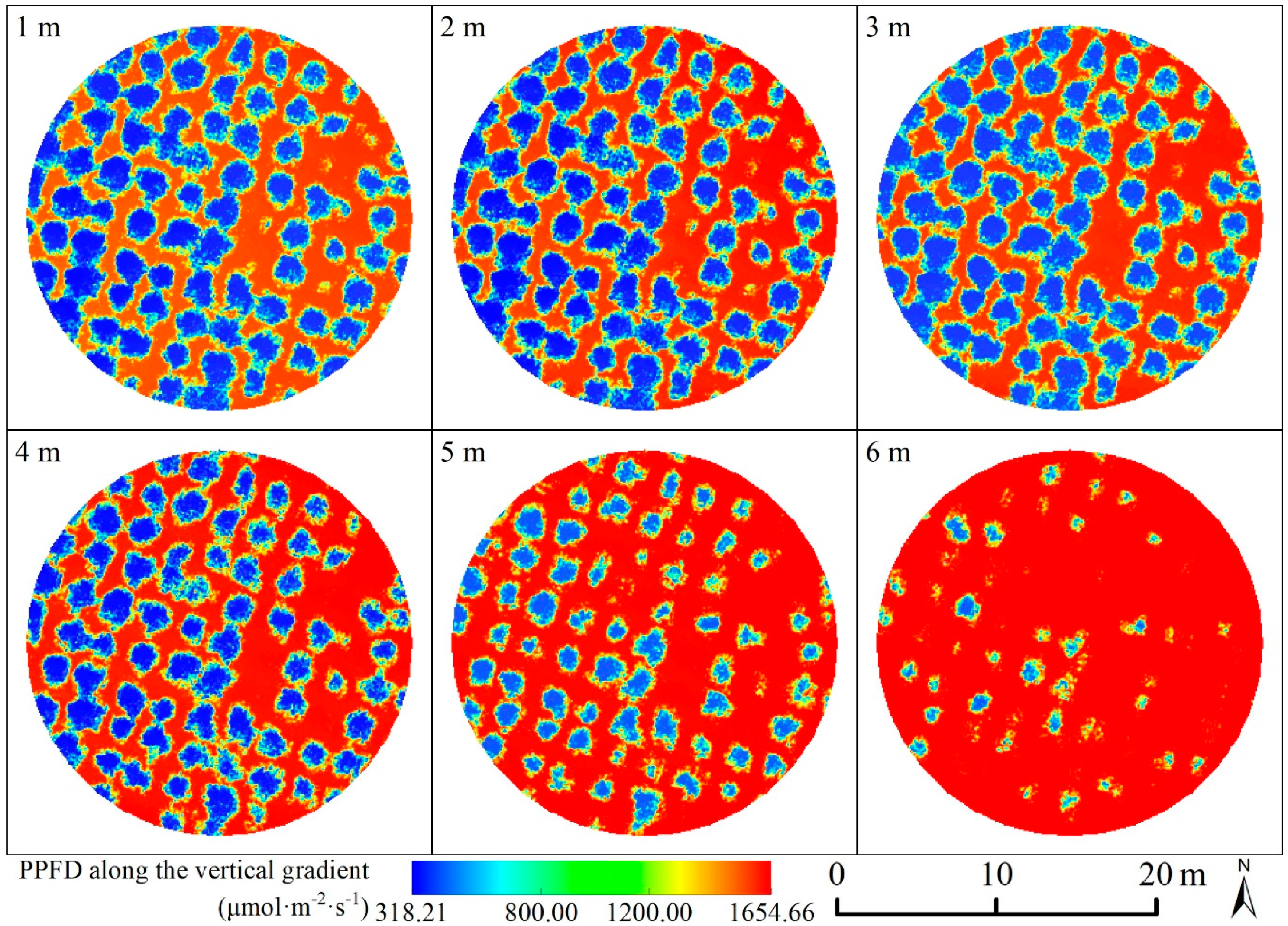


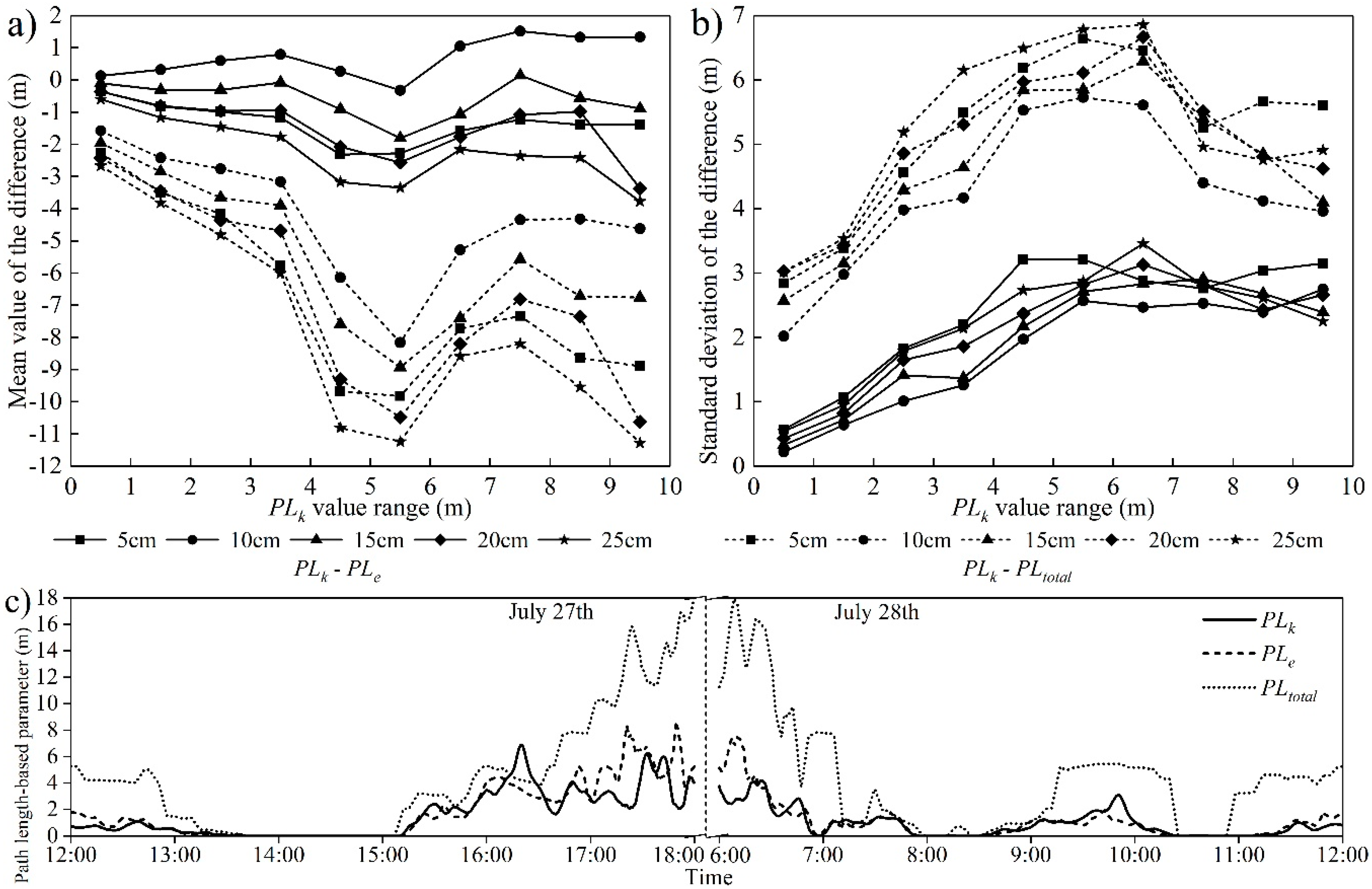



| Location Number | TLS Coordinates | ALS Coordinates | Height (m) | Calibration Coefficients | ||||
|---|---|---|---|---|---|---|---|---|
| X | Y | X | Y | a | b | c | ||
| 1 | −1.345 | −4.365 | 705589.46 | 3499268.53 | 0.36 | 0.60097 | 0.04742 | −0.000033 |
| 2 | −5.668 | −0.948 | 705584.46 | 3499266.03 | 0.21 | 0.51498 | 0.02754 | 0.000025 |
| 3 | 5.183 | 4.881 | 705584.29 | 3499278.50 | 0.33 | −1.30682 | −0.00527 | −0.000076 |
| 4 | −9.307 | 2.416 | 705579.89 | 3499264.47 | 0.32 | −0.59397 | −0.14066 | 0.000002 |
| 5 | −0.368 | 1.468 | 705584.65 | 3499271.91 | 0.75 | 1.00826 | −0.07162 | 0.000014 |
| 6 | −1.909 | −0.590 | 705586.14 | 3499269.84 | 0.12 | −1.19734 | −0.04765 | −0.000072 |
| 7 | 4.066 | −4.846 | 705592.75 | 3499273.31 | 0.38 | 6.77510 | 0.07835 | 0.000033 |
| 8 | 3.422 | 0.422 | 705587.54 | 3499275.07 | 0.73 | 0.24188 | 0.00924 | 0.000024 |
| 9 | −6.873 | −7.958 | 705590.59 | 3499261.92 | 0.11 | −0.63143 | −0.02538 | −0.000011 |
| NPD (cm) | 0°~10° | 10°~20° | 20°~30° | 30°~40° | 40°~50° | 50°~60° | 60°~70° | 70°~80° | ||||||||
|---|---|---|---|---|---|---|---|---|---|---|---|---|---|---|---|---|
| ∆θ1 | ∆φ1 | ∆θ2 | ∆φ2 | ∆θ3 | ∆φ3 | ∆θ4 | ∆φ4 | ∆θ5 | ∆φ5 | ∆θ6 | ∆φ6 | ∆θ7 | ∆φ7 | ∆θ8 | ∆φ8 | |
| (°) | (°) | (°) | (°) | (°) | (°) | (°) | (°) | |||||||||
| origin | 0.3 | 15 | 3 | 0.6 | 3 | 0.3 | 1 | 0.7 | 0.9 | 0.5 | 0.7 | 0.5 | 0.4 | 0.6 | 0.8 | 0.2 |
| 2.5 | 0.3 | 15 | 3 | 0.6 | 3 | 0.3 | 1 | 0.7 | 0.9 | 0.5 | 0.7 | 0.5 | 0.4 | 0.6 | 0.8 | 0.2 |
| 5 | 5 | 1 | 3 | 0.6 | 3 | 0.3 | 1 | 0.7 | 0.7 | 0.7 | 0.7 | 0.5 | 0.4 | 0.6 | 0.8 | 0.2 |
| 7.5 | 3 | 2 | 3 | 0.7 | 3 | 0.3 | 1 | 0.8 | 0.5 | 1 | 0.7 | 0.6 | 0.4 | 0.7 | 0.8 | 0.2 |
| 10 | 3 | 2 | 3 | 0.8 | 3 | 0.4 | 0.3 | 3 | 0.7 | 0.9 | 0.6 | 0.8 | 0.4 | 0.8 | 0.6 | 0.3 |
| 12.5 | 3 | 3 | 3 | 1 | 3 | 0.5 | 3 | 0.4 | 1 | 0.7 | 0.7 | 0.8 | 0.5 | 0.7 | 0.5 | 0.4 |
| 15 | 3 | 3 | 0.7 | 5 | 3 | 0.6 | 2 | 0.7 | 1 | 0.9 | 0.7 | 1 | 0.5 | 0.9 | 0.8 | 0.3 |
| 17.5 | 0.6 | 20 | 0.8 | 5 | 3 | 0.7 | 2 | 0.8 | 0.6 | 2 | 0.9 | 1 | 0.6 | 0.9 | 0.4 | 0.7 |
| 20 | 3 | 5 | 3 | 2 | 3 | 0.9 | 0.4 | 5 | 0.7 | 2 | 0.5 | 2 | 0.7 | 1 | 0.8 | 0.4 |
| 22.5 | 0.8 | 20 | 3 | 2 | 3 | 1 | 3 | 0.9 | 0.6 | 3 | 0.6 | 2 | 2 | 0.4 | 0.4 | 0.9 |
| 25 | 0.8 | 25 | 3 | 3 | 0.7 | 5 | 3 | 1 | 4 | 5 | 3 | 0.5 | 1 | 0.9 | 0.5 | 0.9 |
© 2019 by the authors. Licensee MDPI, Basel, Switzerland. This article is an open access article distributed under the terms and conditions of the Creative Commons Attribution (CC BY) license (http://creativecommons.org/licenses/by/4.0/).
Share and Cite
Zeng, K.; Zheng, G.; Ma, L.; Ju, W.; Pang, Y. Modelling Three-Dimensional Spatiotemporal Distributions of Forest Photosynthetically Active Radiation Using UAV-Based Lidar Data. Remote Sens. 2019, 11, 2806. https://doi.org/10.3390/rs11232806
Zeng K, Zheng G, Ma L, Ju W, Pang Y. Modelling Three-Dimensional Spatiotemporal Distributions of Forest Photosynthetically Active Radiation Using UAV-Based Lidar Data. Remote Sensing. 2019; 11(23):2806. https://doi.org/10.3390/rs11232806
Chicago/Turabian StyleZeng, Kuo, Guang Zheng, Lixia Ma, Weimin Ju, and Yong Pang. 2019. "Modelling Three-Dimensional Spatiotemporal Distributions of Forest Photosynthetically Active Radiation Using UAV-Based Lidar Data" Remote Sensing 11, no. 23: 2806. https://doi.org/10.3390/rs11232806




